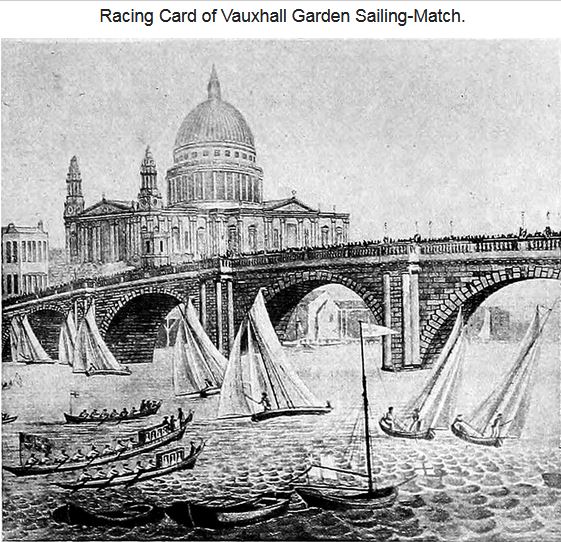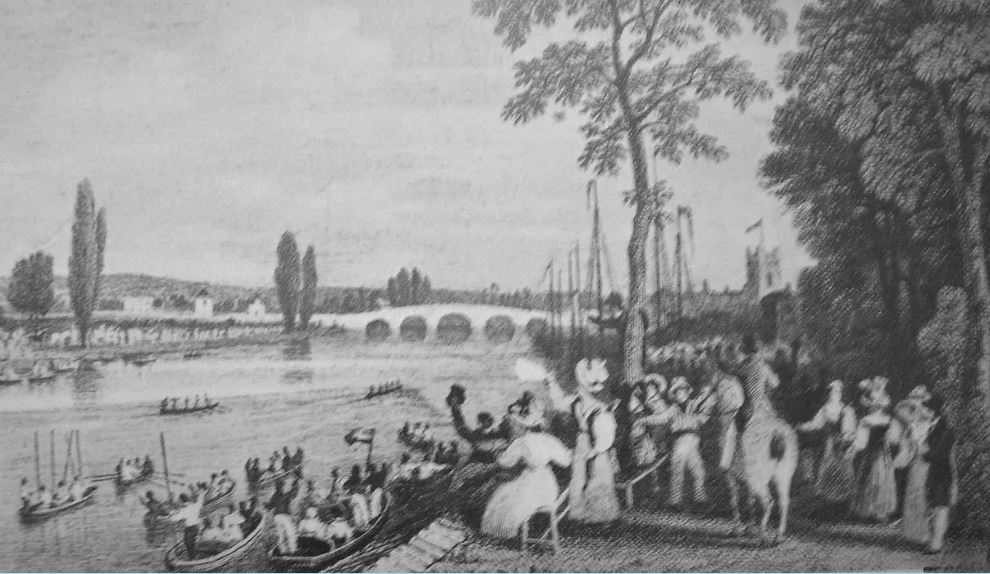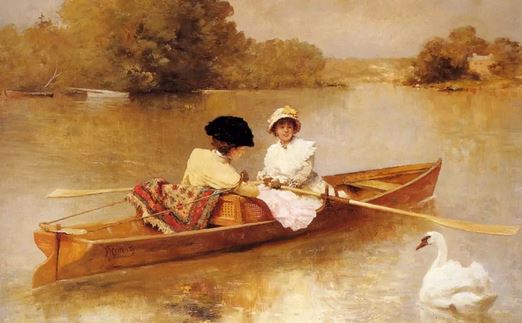We looked at winter sports back in December 2020 and January 2021, and perhaps summer activities seem really obvious since when the sun shines and the days are warmer, what can’t be done outside? But some sports you might expect were not developed or popular until later than the Regency, and others you might not think of. So let’s take a look this month and next.
Boating during the Regency came in three forms based on the source of power. All three offered ways to get out on the water where it might be cooler on a hot summer day! In Sense & Sensibility Jane Austen uses the term “sailing” in reference to boating in general, not necessarily only with sails. Recreational boating was far more likely to involve rowing or punting, which were seldom done on rough waters and were considered to be under much more reliable control by their human operators than those relying on wind.
Sailing (with sails) purely for pleasure was still a little controversial during the Regency, because of safety concerns. For one thing, sailboat design still had a long way to go to reach the sort of safe and efficient crafts we have today. People were working on it, of course, and experimenting with such design is part of the hero’s interest in my old Signet Regency, The Rake’s Mistake. (Sorry, as mentioned last time, it’s out of print because I want to revise it and haven’t made time for that yet.).
However, recreational sailing in England dates all the way back to 1662, when King Charles II and his brother James, the Duke of York, raced their huge new “yachts” from Greenwich to Gravesend and back. By the 18th century pleasure sailing was popular enough for the Cork Harbor Water Club to be established in Ireland, sometime prior to 1720, although they did not race, but “promenaded in formation” when they went out to rendezvous at Spithead. However, an open sailing match was held on the lower Thames in 1749, from Greenwich to the Nore and back. The prize was a silver cup presented by the eleven-year-old Prince of Wales, afterward King George III.
Documented Thames sailing matches in the London vicinity began in 1775 when HRM the Duke of Cumberland offered a silver cup (valued at 20 guineas) for a yachting race. It was sailed from Westminster Bridge to Putney Bridge and back. The next month the Duke of Newcastle sponsored another regatta, and the “Cumberland Fleet” was formed by those who sailed that summer—what would later become the Royal Thames Yacht Club in 1830. The Cumberland Cup and other races were held most years from then on to at least 1812. Vauxhall Gardens also sponsored an annual race on the Thames from 1786 to 1810.
After 1812, the racing record stops, with a gap until some 20 years later. I believe the construction of new, more navigable bridges (Vauxhall, Waterloo, Southwark) complicated racing on the Thames during the building process and increased the river traffic afterward (which included steamboats) during those years. Significantly, between 1812 and 1815, forty-two of Britain’s most distinguished yachtsmen founded the Yacht Club (later to become the Royal Yacht Club) at Cowes on the Isle of Wight. They set a minimum size of ten tons for members’ vessels, and made the racing venue the Solent instead of the Thames.
Rowing, of course, is an ancient art. Think of Cleopatra’s barge! And note the rowers in the Vauxhall race picture above. I’m sure it was only natural that those who plied oars as their business might also indulge in competitions for pleasure and prizes, and others would see the potential for simple relaxation with oars as recreation.
One of the first documented Thames rowing races was held in 1715, to commemorate the anniversary of the accession of King George I. Thomas Dogget, a celebrated comedian, instituted the “coat and badge” as a prize to be rowed for annually on the river by six young watermen that had not been apprenticed longer than a year. In 1821 there was a similar boat race on the Serpentine during the coronation celebration for Prinny. By that time the river traffic and steamboats spelled an end to the rowing races on the Thames in town as well as those under sail.
The Boat Race is an annual set of rowing races between the Cambridge University Boat Club and the Oxford University Boat Club, traditionally rowed between open-weight eights on the upper River Thames from Putney to Mortlake. The men’s race was first held in 1829, quite late in the “extended Regency.” (The first women’s race was in 1927, almost a hundred years later.) The second men’s race was only held in 1836 due to disputes over the course and other matters.
The first Henley Regatta for rowers wasn’t held until March 1839. It later became the Henley Royal Regatta and was moved to July when the weather was more cooperative. Rowing continued to be a popular recreation throughout the 19th century, as this lovely painting below (circa 1872) by Ferdinand Heilbuth shows. Women rowing and punting seems to be more evident later in the century. By that time, the railroads had taken the burden of transportation off the Thames, allowing the river to be used once again for recreation.
Rich or poor, if you were in town you could go out on the River Thames, or you might opt to try the more tranquil waters of the man-made lake in Hyde Park, the Serpentine. The 40 acre lake was created in 1730 by order of Queen Caroline. The bridge crossing it (dividing the lower 25 acres from the narrower “Long Water” at Kensington Gardens) was redesigned and rebuilt in 1827. A lone rower is at the right of the picture below, but far more people are on shore than on the water. I recently learned that starting in the late 18th century there was a rescue station on the Serpentine for assisting those “in danger of drowning”! Rowboats can still be rented to use on the Serpentine today (along with paddle boats).
Most of the wealthy left London for the country when the warm summer days set in. If you were out of the city, you could choose the River Thames farther upstream from London, or any of the local streams, rivers, ponds or lakes. You might be so fortunate and wealthy as to have your very own man-made lake on your country estate, a fad that came into full swing after the royals built the Serpentine. In my old 1996 Signet Regency, An Unlikely Hero (ebook available from Penguin Random House), the hero and heroine are among a party who go punting on just such an estate lake. Punting is essentially “poling,” rather like the gondoliers of Venice, only using the characteristic flat shallow boats called punts. It is still a popular method of boating on English waterways that can be very quiet and relaxing!
Do you like to go out on the water? If so, which form of Regency boating would you have enjoyed if transported back in time?
Next time, we’ll look at some other favorite (land-based) warm weather Regency sports.
(All pictures are public domain/Art)






